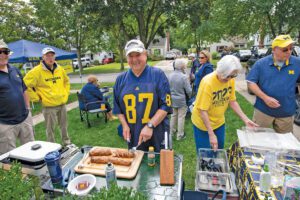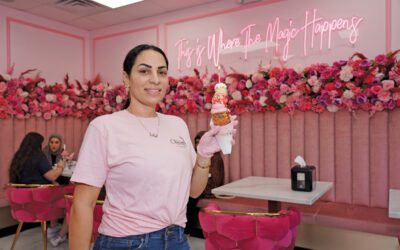In 1959, when I was twelve years old, my best friend’s Uncle Bobby purchased a new Edsel station wagon. He wanted to break it in with a classic tailgate at a Michigan football game on a spectacular fall day. He was offering a free ticket to the Minnesota game, ham-and-cheese sandwiches, deviled eggs, potato chips, chocolate chip cookies, and Faygo cream soda.

At September’s UNLV game, the theme was barbecue. | Photo: Mark Bialek
At the time, it was the best offer I had ever received from anyone.
We parked by the stadium, plopped down on the tailgate, set out the spread, and harassed every Minnesota fan who walked by. After we roasted them, Uncle Bobby offered them a cold beer, pop, and some snacks. My friend and I tossed around a Johnny Latner autographed football. There were no limits on the cream soda. What a great day!
Michigan won a hard-fought 14–0 victory and paraded around the stadium with the Little Brown Jug. We went back to the car and set up for another two hours of tailgating.
I did not think that life could get any better. So in 1966, a year out of high school, a bunch of us decided to create our own perfect tailgate.
—
Those 1960s tailgates were heavy on Pabst Blue Ribbon and Boone’s Farm apple wine. We had donuts in the morning, potato chips, and a few sandwiches. Life was simple.
After seven or eight hours of steady alcohol consumption, we all became brilliant. But though we started to lose focus on some things as the day progressed, we never lost the spirit of camaraderie for our fellow Michigan fans and our opponents.
Before long, the culinary spectrum started to feel a little narrow. We got a cheap charcoal grill and added hot dogs and cheeseburgers. The fire was especially appreciated at the mid-November games.
When we started, the stadium was typically less than half full. We could buy end-zone seats for two bucks and filter down to the 30-yard line to watch the game.
That changed in 1969, when Bo Schembechler took over as head coach and put the team in contention for the Big Ten Championship.
Unfortunately, to win it we had to beat Ohio State, then ranked number one in the country. Bud Wilkinson, the legendary Oklahoma coach, flatly stated that Ohio State was the best college football team since Army in the war years. But Bo won the game, the championship, and a trip to the Rose Bowl.
Suddenly, everyone was a Michigan fan. For us, it just meant arriving earlier and paying more for our tickets. By then, we were grilling bratwurst and Polish sausage, and even chicken breasts for the health conscious.
As we found spouses, children, and careers, the emphasis on alcohol diminished. What did not diminish was our passion for tailgating and college football. We continued to regale fans of the visiting team with highlights of Michigan football history:
“Hey, did you know that Ron Kramer earned nine varsity letters in his career at Michigan? Three each in football, basketball and track. Back then, freshmen were not allowed to play varsity sports or he would have had twelve … Did Wisconsin ever have anyone with that kind of athletic talent? What? Crazy Legs Hirsch!? He couldn’t carry Kramer’s jock strap! How about a brat and a couple beers?”
By then we had locked into a single location behind a house on Hoover St. We arrived earlier and stayed later, bringing provisions for both a pregame and postgame meal.
Things were still fast and loose inside the stadium. At one game in the early 1970s, my wife and I found ourselves seated in the middle of the student section. The fan next to me wore a nice trench coat and a fine Filson hat. He was very short and very quiet. He had an extremely thin neck, a perfectly round torso, and no legs. Next to him were three or four sleeves of plastic beer glasses. Some enterprising students had squirreled a full keg of beer into the stadium, tapped it, and disguised it as Inspector Clouseau.
I spent most of the first half pouring and passing beer. I was amply rewarded by being allowed to drink my fill. Before the band took the field at half time, Inspector Clouseau was drained and the students moved on to Boone’s Farm and Strawberry Hill.
—

Every week someone is assigned the task of ordering several dozen donuts from the Washtenaw Dairy. This photo of Nate, Nick, and Matt
Kivela enjoying them is about a decade old. The boys are bigger now, but dairy donuts are still a staple.
As great as hamburgers, hot dogs, bratwurst, and Polish sausage are, we needed to diversify the postgame feast. We had a nucleus of six or eight couples with outstanding culinary skills. Soon we were creating themed meals for the big dinner after the game. Minnesota is going to be a Mexican feast. In late September, let’s have Oktoberfest. It has to be Irish stew for the Notre Dame game. How about Cajun for Iowa? Everyone pitched in and brought something in line with the theme.
One staple hasn’t changed since 1966: Every week someone is assigned the task of ordering several dozen donuts from the Washtenaw Dairy. These are classic, cider mill–style cake donuts, though some are pumpkin and apple flavored, maple frosted, or covered in maize and blue sprinkles.
From the beginning we had a few rules to guide us, and they never changed: We would never run out of food or drink, and the term “weather permitting” never applied. Football is played regardless of the weather, and we hold the tailgate no matter what.
History lessons continued. As the dreaded Buckeye fans from Columbus passed by we would ask: “Did you know that the famous script ‘Ohio’ was created by the Michigan Marching Band and first performed by the Michigan Band at the 1932 game in Columbus? We are impressed that, at many of the games, your band is able to spell Ohio correctly. How about a donut and a cup of coffee, with or without a shot of Baileys?”
—
In the 1990s, college football and the tailgate continued to evolve. When we lost our spot behind the house on Hoover, we moved to the Pioneer High parking lot. And as college football became a huge financial enterprise, game times were staggered to maximize television revenues.
For more than fifty years, in the words of Bo Schembechler, “leather meets the pigskin at one o’clock.” Now the big bucks TV guys set the starting times, and they range from noon to 7:30 p.m. For the night games, we continue to start at 8:30 a.m. with Dairy donuts, coffee, and Baileys, and maybe a shot of schnapps. We serve the feast around 5 p.m. and continue the tailgate until postgame traffic clears, departing at about 1 a.m.
By now, we’ve acquired a litany of cool equipment. We cook in pots, pans, Dutch ovens, stockpots, and Crock-Pots, on portable propane grills, camp stoves, Nesco cookers, a propane griddle, butane restaurant burners, Weber charcoal grills, and Weber smokers. Prepared hot and cold dishes arrive in spiffy insulated carriers molded to various glass bowls. We have folding tables, Michigan logo tablecloths, every serving utensil known to man, a candelabra with maize-and-blue candles, and a twenty-five-foot flagpole that we anchor under the wheel of a car to fly our colors at the Pioneer High parking lot.
—
Tailgating at Pioneer had a lot of pluses and a few challenges. There are no reserved parking spots, so four or five of us would meet at a mall at 8:15 and drive in together. The rest, arriving later, would be randomly spread around the parking lot.

At Pioneer High, twin flags helped people find us.
At first we flew a Block M flag to help them find us, but so did a hundred other cars in the lot. My son solved the problem by presenting us with a flag that simply showed a frosted mug of beer: To join the tailgate, just walk to the beer flag.
To our consternation, within a few weeks another beer flag showed up at the 20-acre lot. It might be a long walk to check out both flags especially if you were dragging a case and a half of beers in a Coleman cooler. So we bought a second beer flag and told everyone to meet at the two-beer flagpole. No one else ever flew two beer flags and it was a great ice breaker for people passing by.
Two members of our tailgating group are competitive barbecuists. Since anyone within a square mile can smell the finely smoked beef and pork, we get a lot of “drop-ins” at the barbecue tailgate. “We just noticed your Go Blue cutting board. Very cool! Say, is there any chance that the twelve of us could get a small taste of that brisket?”
Another great opportunity for history lessons. “Do you know why the seating capacity for Michigan Stadium is always a big number and 1? Depending on the date of renovation, capacity has been 101,001, 107,001, and 110,001. The extra seat is reserved for the deceased Fritz Crisler, longtime head coach and athletic director for the university. The seat is real but the location is not disclosed. We believe that Fritz comes to every game and we don’t want someone to mistakenly take his seat.”
—
As we moved into the twenty-first century, the young adults who kicked off the odyssey in 1966 had children graduating from college. The daughter of one of the original tailgaters graduated from Michigan and accepted a teaching position at Pioneer. The loving parents offered to help her find a home near the school, with a few minor stipulations: The house needed to be within two blocks of Michigan Stadium, the tailgaters would be allowed to use the yard for all Michigan home games, and we could store some of our tailgating paraphernalia in a corner of the garage.
With the new venue, we humbly decided that our Really, Really, Great Tailgate had become the World’s Greatest Tailgate. One of our banners welcomed visitors to “The A-Maizing Blue Tailgate” with the subtitle, “We Are Professionals Do Not Try This At Home!” Someone bought a golf cart modified with Michigan Football bling that cruised the neighborhood taking our history lessons and opponent harassment on the road, as well as helping injured and infirm fans the two blocks to the Big House.
Another brilliant addition was a full-size soda fountain complete with seven bar stools. Someone else acquired a vintage Hamilton Beach malt machine. At some tailgates we offer banana splits, malts, and milkshakes. At the Mexican tailgate we use it as the staging area for the margarita machine.
Although we have sufficient equipment and provisions to feed an army, we only bring what is needed for each event. We can set up the most complex tailgate in less than thirty minutes. By 9 a.m. we are lounging on an inflatable couch, sampling the first Dairy donuts, and responding to two couples from Purdue who are asking where in the world we found the ice cream parlor.
Despite all the changes, the experience is still a lot like Uncle Bobby’s Edsel station wagon tailgate in 1959: We eat and drink great stuff. We pal around with other like-minded football fans, friends and foe. Every now and then I even bring a Faygo cream soda.
—
We truly view the competition as a game: Games are supposed to be fun. We are happy when our team wins and sad when our team loses. But we are only sad until we get back to the tailgate. Then we are happy again.
We are able to downsize the site in fifteen minutes so that we can head to the stadium and our seats. A few years ago, we were doing that before the Nebraska game. “You’re closing up already?” asked a Cornhusker fan we’d invited in for Polish sausage and a beer. “They won’t kick off for an hour.”
“We know,” we replied. “We are not closing up, we are simply suspending the festivities until after the game. Stop by later and we will feed you corned beef and cabbage to assuage your gut-wrenching loss. The Michigan Marching Band takes the field in forty minutes and all of the Michigan Faithful will be there to see them come out of the tunnel. They will march the length of the field playing every chorus of ‘The Victors.’ This cannot be missed.
“By the way, did you know that John Philip Sousa proclaimed ‘The Victors’ the best college fight song ever written?”




